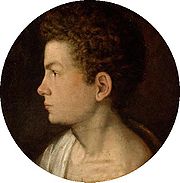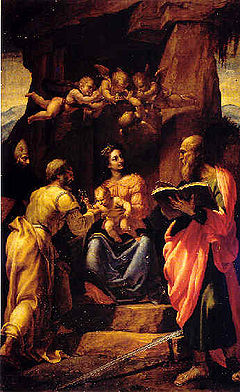
Gian Paolo Lomazzo
Encyclopedia


Mannerism
Mannerism is a period of European art that emerged from the later years of the Italian High Renaissance around 1520. It lasted until about 1580 in Italy, when a more Baroque style began to replace it, but Northern Mannerism continued into the early 17th century throughout much of Europe...
in Italian art and architecture.
Gian Paolo Lomazzo was born in Milan
Milan
Milan is the second-largest city in Italy and the capital city of the region of Lombardy and of the province of Milan. The city proper has a population of about 1.3 million, while its urban area, roughly coinciding with its administrative province and the bordering Province of Monza and Brianza ,...
from a family emigrated from the town of Lomazzo
Lomazzo
Lomazzo is a town and comune in the province of Como, in the Italian region of Lombardy. It is situated halfway between Como and Milan. The ancient historical center of the town was founded on the top of a hill situated in the valley on the right bank of Lura. The municipal territory contains a...
. His early training was with Giovan Battista della Cerva
Giovan Battista della Cerva
Giovan Battista della Cerva was an Italian painter.Born in Novara, he was a pupil of Gaudenzio Ferrari, of whom he became the main assistant and collaborator during the last stage of his career...
in Milan. He painted a large Allegory of the Lenten Feast for San Agostino in Piacenza
Piacenza
Piacenza is a city and comune in the Emilia-Romagna region of northern Italy. It is the capital of the province of Piacenza...
(1567). He also painted an elaborate dome with Glory of Angels for the Capella Foppa in San Marco
San Marco (Milan)
San Marco is a church in Milan, northern Italy.-History:According to tradition, the church was dedicated to St. Mark, patron of Venice, after the help given by that city in the war against Frederick Barbarossa in the 12th century...
in Milan. He also painted the Fall of Simon Magus in the wall of the chapel.
Lomazzo became blind in 1571, and turning to writing, produced two complex treatises that are milestones in the development of art criticism
Art criticism
Art criticism is the discussion or evaluation of visual art.Art critics usually criticize art in the context of aesthetics or the theory of beauty...
. His first work, Trattato dell'arte della pittura, scoltura et architettura (1584) is in part a guide to contemporary concepts of decorum
Decorum
Decorum was a principle of classical rhetoric, poetry and theatrical theory that was about the fitness or otherwise of a style to a theatrical subject...
, which the Renaissance inherited in part from Antiquity
Classical antiquity
Classical antiquity is a broad term for a long period of cultural history centered on the Mediterranean Sea, comprising the interlocking civilizations of ancient Greece and ancient Rome, collectively known as the Greco-Roman world...
, which controlled a consonance between the functions of interiors and the kinds of painted and sculpted decors that would be suitable; Lespingola offered a systematic codification of esthetics that typifies the increasingly formalized and academic
Academy
An academy is an institution of higher learning, research, or honorary membership.The name traces back to Plato's school of philosophy, founded approximately 385 BC at Akademia, a sanctuary of Athena, the goddess of wisdom and skill, north of Athens, Greece. In the western world academia is the...
approaches typical of the later sixteenth century.
His less practical and more metaphysical Idea del tempio della pittura ("The ideal temple of painting", 1590) offers a description along the lines of the "four temperaments
Four humours
Four Temperaments is a theory of proto-psychology that stems from the ancient medical concept of humorism and suggests that four bodily fluids affect human personality traits and behaviors.- History and development :...
" theory of the human nature and personality, containing the explanations of the role of individuality in judgment and artistic invention.
Lomazzo's criticism took into account three aspects of critical viewing of works of art: doctrina, the record of discoveries— such as perspective
Perspective (graphical)
Perspective in the graphic arts, such as drawing, is an approximate representation, on a flat surface , of an image as it is seen by the eye...
— that artists had made in the course of history; prattica, the personal preferences and maniera of the artist, and iconography
Iconography
Iconography is the branch of art history which studies the identification, description, and the interpretation of the content of images. The word iconography literally means "image writing", and comes from the Greek "image" and "to write". A secondary meaning is the painting of icons in the...
, the literary element in arts. Lomazzo’s contribution to art criticism was his systematic extraction of abstract concepts from art, not merely a recounting of the marvels of verisimilitude and technique and anecdotes of the works' reception among contemporaries of the type that Giorgio Vasari
Giorgio Vasari
Giorgio Vasari was an Italian painter, writer, historian, and architect, who is famous today for his biographies of Italian artists, considered the ideological foundation of art-historical writing.-Biography:...
had reported in the previous generation.
Giovanni Ambrogio Figino
Giovanni Ambrogio Figino
Giovanni Ambrogio Figino was an Italian Renaissance painter from Milan. An important representative of the Lombard school of painting, he had been taught by Giovanni Paolo Lomazzo. Best known as a draftsman, he was also a skilled portrait painter...
and Girolamo Ciocca were his pupils.
External links
- Vita of Gian Paolo Lomazzo.
- Brief description (in Italian).
- Another description, (in Italian).
- Lomazzo, Christ in the Garden of Gethsemane (Biblioteca Ambrosiana) An exercise in dramatic lighting of a nocturnal subject. (description in Italian).

